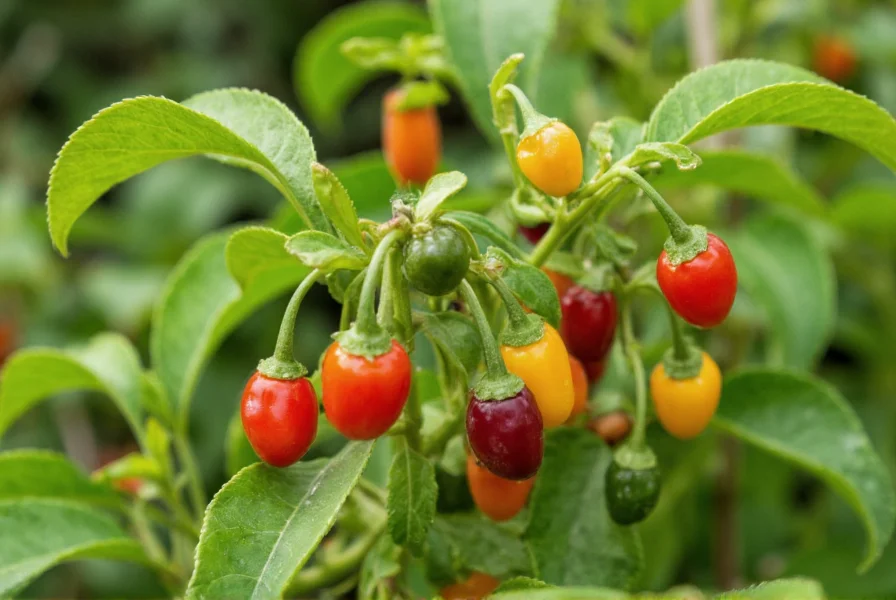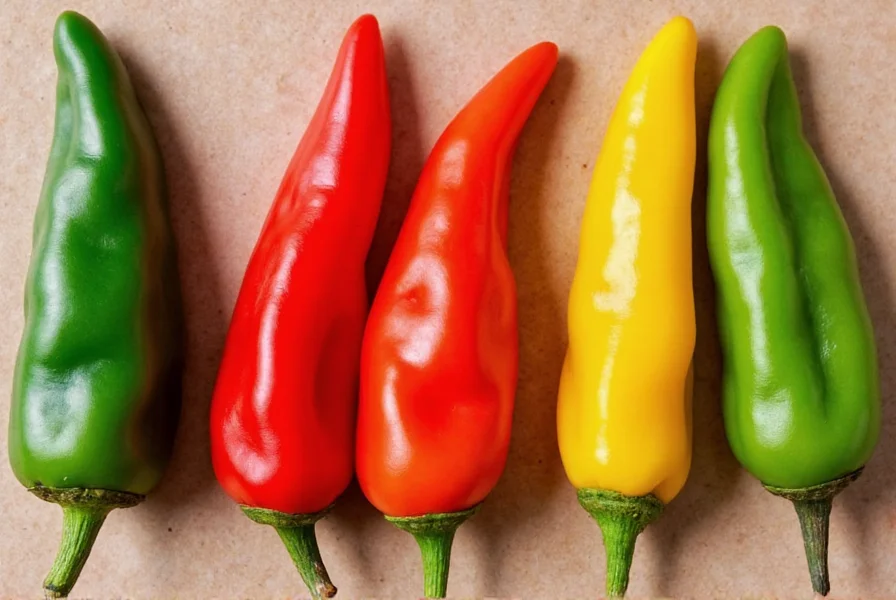The term '5 color chinese pepper seeds' refers to Capsicum annuum varieties known as Chinese 5 Color or Black Pearl peppers. These ornamental chili plants produce small, tapered fruits that transition through five distinct color stages as they mature: starting as deep purple, then yellow, orange, bright red, and finally dark crimson. While edible with mild to medium heat (5,000-10,000 SHU), they're primarily cultivated for their striking visual appeal in gardens and containers.
Chinese 5 Color pepper plants represent one of gardening's most visually captivating ornamental varieties. These compact bushes, typically reaching 12-24 inches in height, showcase an extraordinary color progression that makes them prized additions to both vegetable gardens and decorative container arrangements. Unlike standard chili varieties that maintain a single color throughout ripening, these Chinese heirloom peppers undergo a remarkable chromatic transformation that provides months of visual interest.
Understanding the Color Transformation Process
What makes Chinese 5 Color peppers truly unique is their multi-stage ripening process. The journey begins with deep purple fruits that gradually shift through a spectrum of colors:
| Stage | Color | Timeframe After Flowering | Flavor Profile |
|---|---|---|---|
| 1 | Deep Purple | 2-3 weeks | Mild, slightly bitter |
| 2 | Yellow | 3-4 weeks | Subtly sweet |
| 3 | Orange | 4-5 weeks | Balanced sweet-heat |
| 4 | Bright Red | 6-7 weeks | Classic chili flavor |
| 5 | Dark Crimson | 8+ weeks | Complex, full-bodied heat |
This color progression occurs simultaneously on the same plant, creating a stunning visual display where multiple colors appear together. The transformation reflects changing pigment concentrations as chlorophyll breaks down and carotenoids develop. Gardeners often report that proper sunlight exposure intensifies the color vibrancy, making these peppers particularly striking when grown in full sun conditions.
Cultivation Requirements for Optimal Growth
Successfully growing Chinese 5 Color peppers requires attention to specific environmental factors. These plants thrive in warm conditions with consistent moisture and well-draining soil. Starting seeds indoors 8-10 weeks before the last frost date gives them the head start they need, as they require a long growing season to complete their full color cycle.
When transplanting outdoors, select a location with at least 6-8 hours of direct sunlight daily. The ideal soil pH ranges between 6.0 and 7.0, with amended garden soil containing compost or well-rotted manure providing optimal nutrition. Container growers should use pots at least 12 inches in diameter with drainage holes, filled with high-quality potting mix.
Watering requires consistency—allowing the soil to dry slightly between waterings prevents root rot while maintaining adequate moisture for fruit development. During flowering and fruit set, a balanced fertilizer with higher phosphorus content supports healthy development. Many gardeners report that slightly stressing the plants by reducing water just before harvest intensifies both color and flavor.

Harvesting and Culinary Applications
Harvest timing depends on your intended use. For maximum visual impact in arrangements, pick peppers when they've reached their final crimson stage. For culinary purposes, many chefs prefer harvesting during the orange to red transition when flavor complexity peaks. Use sharp scissors or pruning shears to cut peppers from the plant, leaving a small stem attached to prevent damage.
While primarily ornamental, these peppers offer surprising culinary versatility. Their heat level ranges from mild to medium (5,000-10,000 Scoville units), making them accessible to most palates. The flavor profile evolves with color: purple peppers offer earthy notes, yellow provide subtle sweetness, orange deliver balanced flavor, red present classic chili taste, and crimson varieties showcase deep, complex heat.
Chefs incorporate these colorful peppers into dishes where visual presentation matters—think vibrant salsas, decorative garnishes, or pickled pepper assortments. Home gardeners often dry the fully ripened fruits for use in winter cooking or create decorative wreaths that serve both aesthetic and practical purposes.
Common Growing Challenges and Solutions
Gardeners cultivating Chinese 5 Color peppers may encounter several common issues. Blossom drop often occurs during temperature extremes—both excessive heat above 90°F (32°C) and cool temperatures below 60°F (15°C) can cause flowers to fall before setting fruit. Maintaining consistent soil moisture and providing afternoon shade during heatwaves helps mitigate this problem.
Spider mites represent a frequent pest challenge, particularly in dry conditions. Regularly spraying the undersides of leaves with water or using insecticidal soap controls these pests effectively. For prevention, maintain proper plant spacing to ensure good air circulation around each plant.
Nutrient deficiencies may manifest as yellowing leaves or poor fruit set. A balanced fertilizer regimen addressing nitrogen, phosphorus, and potassium needs, supplemented with calcium to prevent blossom end rot, typically resolves these issues. Container growers should refresh soil annually to maintain nutrient levels.

Comparison with Similar Ornamental Varieties
While several ornamental pepper varieties exist, Chinese 5 Color peppers stand apart through their distinctive color progression. Unlike Black Pearl peppers that transition primarily from black to red, or Medusa peppers that display multiple colors simultaneously but without the sequential progression, Chinese 5 Color varieties showcase a clear, stage-by-stage transformation.
Compared to standard bell peppers or jalapeños, these Chinese varieties remain significantly smaller (typically 1-2 inches long) and produce higher yields of colorful fruits throughout the season. Their compact growth habit makes them particularly suitable for container gardening, where space might be limited but visual impact remains important.
Gardeners seeking variety might consider growing Chinese 5 Color peppers alongside complementary plants like basil, marigolds, or nasturtiums. These companion plants not only enhance visual appeal but can also help deter pests and improve overall garden health through beneficial insect attraction.
Seasonal Care and Overwintering Techniques
As tender perennials in USDA zones 9-11 but typically grown as annuals elsewhere, Chinese 5 Color peppers can be overwintered indoors with proper care. Before the first frost, cut plants back by one-third and transplant into containers. Place them in a sunny window or under grow lights, reducing watering frequency during the shorter daylight months.
During winter dormancy, maintain temperatures above 55°F (13°C) and water only when the top inch of soil feels dry. In early spring, gradually increase watering and fertilizing as daylight hours lengthen. Prune any leggy growth to encourage bushier plants when moving back outdoors after the last frost date.
Overwintered plants often produce earlier and more abundantly than newly started seeds, making the extra effort worthwhile for dedicated gardeners. This practice also preserves specific genetic lines that might be difficult to source commercially in subsequent years.
Practical Applications Beyond the Garden
The versatility of Chinese 5 Color peppers extends beyond fresh consumption. Their vibrant colors make them ideal for natural dye production, with each color stage yielding different hues for fabric or craft projects. The dried fruits maintain their color remarkably well, allowing for year-round decorative use in wreaths, potpourri, or holiday arrangements.
Educators find these peppers particularly valuable for teaching plant biology concepts. The visible color changes provide concrete examples of pigment development, photosynthesis changes, and fruit maturation processes. School gardens often incorporate these plants specifically for their educational value in demonstrating plant life cycles.
Photographers and artists appreciate the dramatic color contrast these peppers provide, using them as subjects for still life compositions or as natural color references in various creative projects. The compact size and extended color display make them particularly suitable for close-up photography and detailed artistic renderings.
Final Considerations for Gardeners
Chinese 5 Color pepper plants offer a unique combination of ornamental beauty and culinary utility that few other garden plants can match. Their extended color display provides months of visual interest while producing edible fruits that add both flavor and visual appeal to culinary creations. Whether you're an experienced gardener looking to expand your collection or a beginner seeking an attractive, manageable plant, these peppers deliver exceptional value through their multi-dimensional appeal.
By understanding their specific growing requirements and appreciating their distinctive characteristics, gardeners can successfully cultivate these remarkable plants and enjoy their spectacular color progression throughout the growing season. The relatively low maintenance requirements combined with high visual payoff make Chinese 5 Color peppers an excellent choice for container gardens, border plantings, or dedicated vegetable patches.











 浙公网安备
33010002000092号
浙公网安备
33010002000092号 浙B2-20120091-4
浙B2-20120091-4